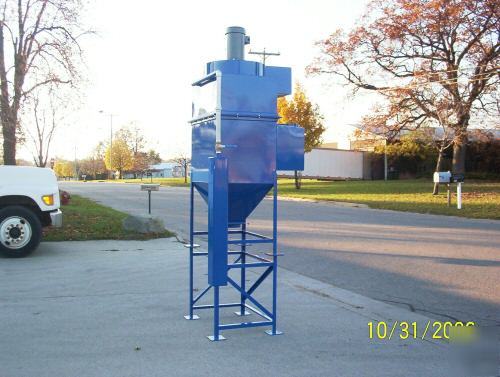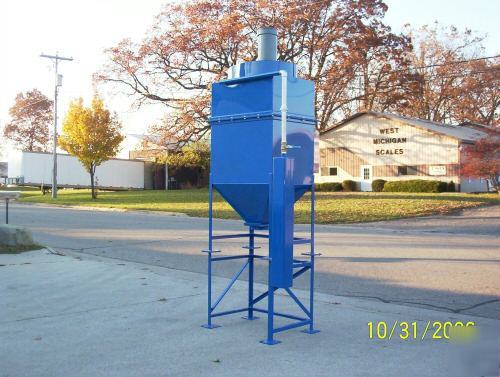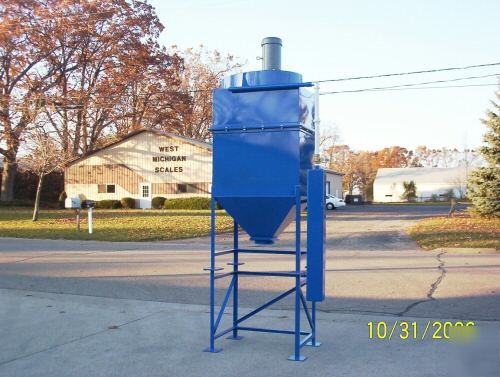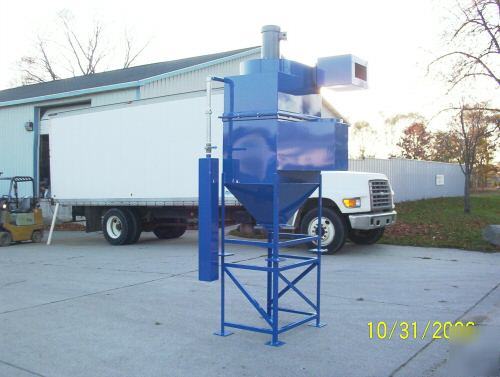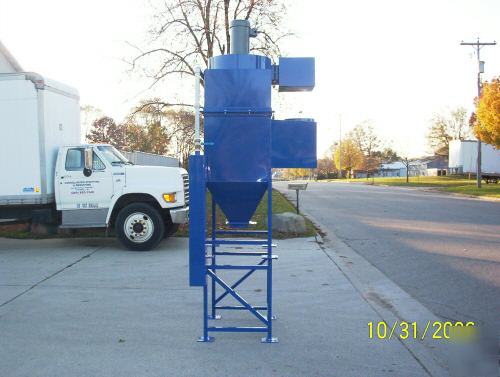 Up
Up
|
This listing is for a new 3500 cfm, pulse clean, cartridge style dust collector. The cartridge dust collector is an excellent choice to replace the common bag-house or dust bag type collector and can be used to collect almost any dry, fine dust particulate. The cartridge offers a large amount of cleaning filter material in a very compact area. Cartridge dust collectors take up much less space than bag house collectors and offer an impressive filtration efficiency of 99.7% against 1/2 micron particles. It was designed with a 12 inch diameter, abrasive resistant, inlet to extend the filter life. The filters are cleaned with a single reverse pulse of compressed air during a down-time period. The reverse pulse is manually actuated with a 1 1/4 manual ball valve located on the front of the unit. It is most effective when used each time the dust collector is shut down, generally 1 to 2 times per day. This unit is equipped with an acoustical dampening package that will meet or exceed all noise level requirements per osha specifications. This collector offers an impressive 16 inch diameter straight radial impeller that generates a maximum static draw of 13.3 inches of water column. At this level of vacuum an automated pulse would not allow the thorough removal of the dust cake with a single pulse. The vertical placement of filters allow for the best possible release and removal of dust from the pleated filters with one reverse pulse. It has two 99.7 % efficient cartridges that contain 452 square feet of total cleaning surface area. Each 26 inch long and 12.75 inch diameter filter cartridge has pleats that are 2.375 inches deep. The center opening of the filter is 8 inches in diameter and is open on both ends before installation. Currently, it is offered with a 7.5 hp, (208 - 230 / 460) 3 phase TEFC motor as standard equipment (19 -17 / 8.6 amps). It is also available with Csa or EU certified motor if required. The approx. dimension of this collector is 8 ft. high, 5 ft. wide and 4 ft. deep. CAUTION: VERY DETAILED INFORMATION VERTICAL VS. HORIZONTAL SYSTEMS This unit uses a vertical filter system that offers three major advantages over conventional horizontal filter collectors. The first advantage is that the dust cake does not pulse onto the filter located directly below it. Most filter cartridges are pleated to expand the filter material. This is why they offer high square footage of filter material in a very compact area. Most cartridges have pleats that are 2 to 3 inches deep. These pleats run perpendicular to the top and bottom plate that anchors the filter material in place, much like the grooved support columns pictured on the back of a $5.00 bill. The grooves represent the filter pleats. Vertical filter systems allow the dust cake to be evenly pulsed off 360 degrees around the filter circumference. The pleats are pointing outward from the center of the filter from top to bottom. Gravity is then aiding in the removal of the dust cake. It is blown off and falls away from the filter and not onto another filter located directly below it. No matter how high the filter column is, the waste material always falls off evenly without affecting other filters. But a horizontally oriented filter system must pulse 40% of the filter in an upward direction because the orientation of the pleats is pointing upward. A good example is to position the building on the back of our $5.00 bill demo in the wrong direction. Then gravity is working against the released dust cake. Gravity will pull the dust back down and onto the top portion of the filter, not to mention the additional effects of the vacuum which we will cover later. Placing a cartridge in a dust collector unit horizontally causes the pleats on the top half of the filter cartridge to effectively fill up like a paper file folder and render this area severely impaired and impossible to clean as only the top filter is exempt from having added dust dumped on it from the filter directly above it. The second advantage of vertical filter systems is that the pleats are held securely in an up to down configuration. Take that $5.00 bill and fold it in half the long way and crease it firmly in the center. It will now stand rigid on a flat surface and will exhibit considerable strength against a downward applied force when the crease is running vertically. But if you lay it down with the crease running horizontally it will fold up and flatten with very little downward pressure. So too will the paper composite pleats sag downward when they fill with dust. This is especially true at the center of the filter. The weight of the dust causes the top pleats to open like our example. This makes even more room for dust between the pleats which compounds the problem. The weight of this dust causes the pleats to sag downward along the sides of the filter and compresses them together at the bottom of the filter. The longer this goes on, the weaker the filter material becomes and the worse it will sag. If the weight becomes too great, it can actually cause the filter to rupture. But this compression of the lower pleats and filling of the top pleats further reduces air flow thru the filter in these areas. This sag is completely eliminated in a vertical filter system because any added weight from the dust cake is constantly pulling the pleats rigid. So the more pull is exerted against the pleats the more rigid they become where as a pushing force would cause them to fold over easily. This is important because when you pulse a filter that is very heavy with dust in the vertical position you have built in extra rigidity. But when you pulse a filter heavy with dust in the horizontal position you add additional stresses that are never present in the vertical system. This is especially true during the pulse cycle of an automatic system, when the filter goes from a vacuum to the positive pulse wave and back to a vacuum in a fraction of a second. The third major advantage of a vertical filter system is a composite of the first two listed above. But in light of the first two reasons, a vertical system can use less than half the number of filters without changing any internal dynamics which will be covered later on. This saves money by eliminating unnecessary filters and unnecessary filter change-outs due to premature wear and filter media degradation. On average you will experience 2-4 times the life expectancy out of identical filters under identical circumstances in a vertical system. And it saves floor space. In the above examples alone, half of the filters, based on total surface area, have been rendered useless within days if not hours of operation in a horizontal dust collector system. Over the life of a dust collector, you should expect to spend up to 8 times the amount on filter replacements with a horizontal filter system. The best time to clean any cartridge filter is during a down-time period when it is not possible to suck the dust cake back onto the filter. One pulse during a down-time period does a better job of filter cleaning than several pulses when a collector is running regardless of the filter orientation. When any dust collector is running, it is creating a vacuum on the filters and working against the objective of blowing the dust cake off of the filters. This vacuum is usually expressed in inches of water column. Most industrial collectors fall into the high pressure classification. Anything over 3 inches of water column is considered to be high pressure and this vacuum is usually created by a spinning impeller of various size, speed and directional vector. Three major styles of high pressure impeller are common; the straight radial, forward inclined and backward inclined. These impellers create the vacuum and they set the maximum static pressure and cfm the system is capable of generating within the impeller scroll housing. Straight radial blades create the highest vacuum and are also the loudest of the three. The backward inclined blade is much quieter than a straight radial blade but is generally only capable of producing 6 inches or less of water column. Forward inclined blades are usually highly specialized blades and are not very common in the dust collection industry. This information is important and will be relevant latter on in this document. The total amount of vacuum any system can produce must then be used to pull or push the air thru a filtration device. Most industrial units will use the pull thru scenario so that only cleaned air is allowed to enter into the impeller chamber and in this way wear associated with dust filled air is avoided. This also prevents waste matter from building up behind low pressure areas of the impeller that can cause poor performance in backward inclined impellers. At this time, we will limit our scope to the pull thru impeller system. The impeller vacuum is then evenly distributed thruout the entire filter area system. The greater the number of filter openings and the greater the combined filter surface area available, the less the vacuum will be per square foot of filter area and the easier it becomes to pulse the filters while a system is running. This ratio at the filter level is often referred to as a cloth to air ratio. Most automated pulse systems are designed for a 1 : 2 cloth to air ratio. In example, a 3500 cfm automatic pulse dust collector at a 1 : 2 ratio would require approximately 1,750 square foot of filter area or about 8 standard filters. The cloth to air ratio on this listed unit is 1 : 8 or about 4 times the air speed through the filter media of most other collectors. If that seems substantial, let us consider the actual speed of the air moving through the filter media in miles per hour. At a 1 : 2 ratio, 3500 cfm / 1700 sq. ft. of filter media = 2.05 linear ft. of air per minute or .02 miles per hour thru the filter. That is 1/2 mile in a 24 hour day. Not exactly moving at warp speed. This listed unit has 4 times that air speed at only .08 mph or about 2 miles in a 24 hour day. The point is, that a major reason so many filters are required on most conventional dust collectors is because they are designed around automating the pulse cleaning, with air filtration a secondary objective. An automated pulse system cleans better as the air flow thru the filter gets closer to zero. It is, in fact, the major defining factor about which everything else on the typical collector is engineered around. It also causes the greatest number of obstacles to be overcome. In order to achieve automation, all dust collector manufacturers must deal with these very fundamental realities. So instead of actually causing the air flow thru the filter to become zero by turning off the system, they try to create an almost static air flow, by reducing the total air speed thru the filter media to as close to zero as possible. And there is a very good reason why it is done in this way. Most automated systems cannot be pulsed during a down-time period when there is no suction. They rely on pressure switches like a magnehelic or photohelic gauge to trigger the pulse and the system must be on to use these triggers. Therefore, an additional computerized system would be required to allow down-time cleaning, at an additional cost. Torit Donaldson and the Torit Downflow brand collectors have the best know system, called a Checker Board. It allows for programmable down-time cleaning. But this system, and others like it, add big expense to accomplish a simple task. Torit will suggest that you purchase one because the collectors function much better with down-time cleaning and they will also suggest that it will improve the life of the filters and save money in the long run. All this is true for the very reasons explained above. But why pay extra for something that can be done so easily and without any additional cost? Total static pressure is also very important to consider. The higher the static pressure a system can deliver the more resistance it has the ability to work thru. Long runs of duct work for inlet or exhaust, multiple bends, temperature, altitude, and filter loads can all add resistance. For every one inch of resistance a system must work thru, one inch of delivered capacity is removed. But as a percentage this becomes significant. If a system with 10 inches of static pressure has one inch removed thru resistance you have 90% capacity remaining. But if a system only has 5 inches of static pressure available and one inch is removed thru resistance then only 80% capacity remains and air flow is decreased by 10% or 20% respectively by the same amount of applied resistance. But resistance is not just limited to the filters as stated above but includes all loads that must be worked thru to create delivered air. Having a low static pressure to aid in filter cleaning, can produce a system that has an impaired ability to work thru other potentially substantial loads, which include but are not limited to filter loading. Because filter loading is only one consideration, this unit produces high levels of static pressure, and higher filter air flow speeds than most similar capacity collectors. This makes automated pulsing impractical without substantial adverse changes to its engineering. This unit cannot be converted to an automated pulse system for the above reasons. But it does have the ability to work thru substantial loads including substantially higher filter loading. The ability to work thru a filter load in particular is important because the major reasons filters require replacement is wear and tear caused in part by the reverse pulse of compressed air. This pulse is very powerful and can abraid the filter media during the quick removal of a heavy dust cake, especially in horizontally oriented filters. Compressed air can also contain oil or water, that if present can saturate the filter and cause the dust cake to become sticky and solidify on the surface of the filter media. In short, the more often a filter is pulsed the sooner it will require replacement, regardless of the amount of dust collected. The fewer pulses required to thoroughly clean a filter the better. In this case, unlike this document, less is really more. In conclusion, the best reason to place a filter horizontally is to make them easier to change. Ironically, it also causes them to need replacement four times as often, but this is the goal of most manufacturers. The only stream of revenue after the sale is filter replacement and it is to the manufacturers benefit to use many filters, to make them easy to change and to engineer them to fail in a predictable manner. THEY ARE ENGINEERED TO FAIL! IT IS PLANNED OBSOLESCENCE! |

